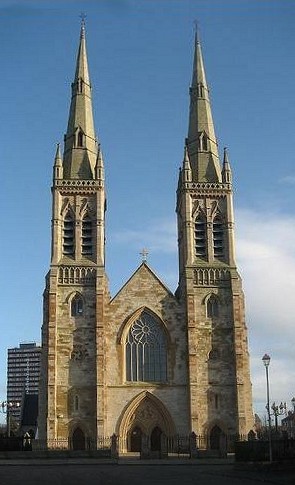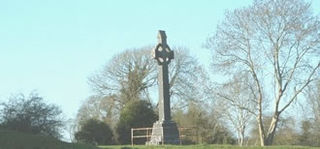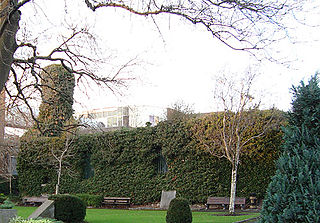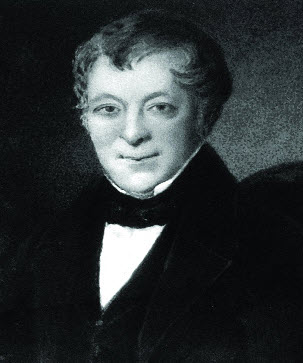
Christ Church Cathedral, more formally The Cathedral of the Holy Trinity, is the cathedral of the United Dioceses of Dublin and Glendalough and the cathedral of the ecclesiastical province of the United Provinces of Dublin and Cashel in the (Anglican) Church of Ireland. It is situated in Dublin, Ireland, and is the elder of the capital city's two medieval cathedrals, the other being St Patrick's Cathedral.

The Pallottines, officially named the Society of the Catholic Apostolate, abbreviated SAC, is a Society of Apostolic Life of Pontifical Right for men in the Roman Catholic Church, founded in 1835 by the Roman Catholic priest Saint Vincent Pallotti. Pallottines are part of the Union of Catholic Apostolate and are present in 45 countries on six continents. The Pallottines administer one of the largest churches in the world, the Basilica of Our Lady of Peace of Yamoussoukro in Côte d'Ivoire.

The Diocese of Down and Connor, is a Latin Church ecclesiastical territory or diocese of the Catholic Church in Northern Ireland. It is one of eight suffragan dioceses in the ecclesiastical province of the metropolitan Archdiocese of Armagh. Bishop Alan McGuckian is Bishop.

Aughrim is a small village in County Galway, Ireland. It is located between the towns of Loughrea and Ballinasloe, along the old N6 national primary road that used to be the main road between Galway and Dublin. According to the Irish census of 2011, the division had a population of 595.

St Audoen's is the church of the parish of St Audoen that is located south of the River Liffey at Cornmarket in Dublin, Ireland. The parish is in the Roman Catholic Archdiocese of Dublin. The church is now home to the Polish chaplaincy in Ireland. There is an Anglican church of the same name adjacent to it.

Holy Cross College, located on Clonliffe Road, Drumcondra, was founded in 1854 as the Catholic diocesan seminary for Dublin by Paul Cullen, Archbishop of Dublin (later created, in 1866.

There was a St. Kevin's Church in what is now St. Kevin's Park, Camden Row, Dublin, Ireland at least as far as the 13th century. After the Reformation, it became an Anglican church. The original church was replaced around 1750 by a new one, closed in 1912 and now in ruins. Both churches were dedicated to Kevin of Glendalough. There is also a Catholic St. Kevin's Church a short distance away on Harrington Street.

St Dominic's Priory Church is one of the largest Catholic churches in London. The church is Grade II* listed building on the National Heritage List for England. It has been served by the Order of Preachers (Dominicans) since 1861, the community living in the adjacent Priory. In October 2016, the church was solemnly inaugurated by the Cardinal Archbishop of Westminster, Vincent Nichols, as a diocesan shrine, with a designated mission of promoting the Rosary.

The Church of St Nicholas of Myra (Without) is a Roman Catholic church on Francis Street, Dublin that is still in use today. The site has been used as a place of worship as far back as the 12th century. The current church was built in 1829 and dedicated to Saint Nicholas in 1835.

Patrick Byrne was an Irish architect who built many Catholic churches in Dublin. He also served as a vice president of the Royal Institute of the Architects of Ireland.
Patrick Bonaventure Geoghegan, O.F.M. (1805–1864) was an Irish Roman Catholic clergyman who served firstly as Bishop of Adelaide. Born in Dublin, he became a Franciscan friar and served at a Dublin parish before volunteering for Australia. After five years as Bishop of Adelaide, He returned to Ireland, intending to stay only briefly. He was named Bishop of Goulburn, Australia, but died before he could assume the post.

Grangegorman is an inner suburb on the northside of Dublin city, Ireland. The area is administered by Dublin City Council. It was best known for decades as the location of St Brendan's Hospital, which was the main psychiatric hospital serving the greater Dublin region. As of 2020, the area is the subject of a major redevelopment plan, running for more than a decade, under the aegis of the Grangegorman Development Agency, including the new Technological University Dublin campus.

The Cathedral of the Immaculate Conception is the cathedral church of the Roman Catholic Diocese of Elphin. It is located on Temple Street in Sligo, Ireland. The cathedral was developed by Bishop Laurence Gillooly who had been appointed Bishop of Elphin in 1858. He decided that the diocese was now of a size and wealth that the time had come to replace St. John's Parish Chapel, which had been recognised as the diocesan pro-cathedral.
Patrick Russell was an Irish Roman Catholic prelate. He was Archbishop of Dublin from August 1683 until his death, having been imprisoned owing to his support for Jacobitism.

Holy Trinity Church, also known as Father Mathew Memorial Church, is a Roman Catholic Gothic Revival church and friary on Fr. Mathew Quay, on the bank of the River Lee in Cork. It belongs to the Order of Friars Minor Capuchin and is the only church dedicated to Father Theobald Mathew.

The Fordham University Church is a Catholic (Jesuit) church located at Fordham University in the Bronx, New York City. Originally constructed in 1845, the church was initially used as a seminary for the community, and later became part of the university in 1859. Contemporarily, it is the central place of worship and head of the university's campus ministry, which also has various associated chapels across the university's three campuses.

St. Michan's Catholic Church is a Catholic Church located on the Northside of Dublin, Ireland. It is the parish church for the Halston Street Parish in the Archdiocese of Dublin.

The Diocese of Tuam, Limerick and Killaloe is a diocese of the Church of Ireland that is located in the west of Ireland. The diocese was formed by a merger of the former Diocese of Tuam, Killala and Achonry and the former Diocese of Limerick and Killaloe in 2022, after the retirement of the separate dioceses' bishops and the appointment of Michael Burrows as bishop of the united diocese. It is in the ecclesiastical province of Dublin. It is one of the eleven Church of Ireland dioceses that cover the whole of Ireland. The largest diocese by area in the Church of Ireland, it covers all of counties Clare, Galway, Kerry, Limerick and Mayo, plus parts of counties Cork, Sligo, Roscommon, Offaly, Laois and Tipperary.

St. Saviour's Priory, Dublin, is a convent of the Dominican Order, in Dublin, founded in 1224. Its present church has, since 1974, also served as a parish church for the local area, The priory has also been, since 2000, the House of Formation of the Irish Dominican Province, hosting the so-called Studium generale of the province.



















